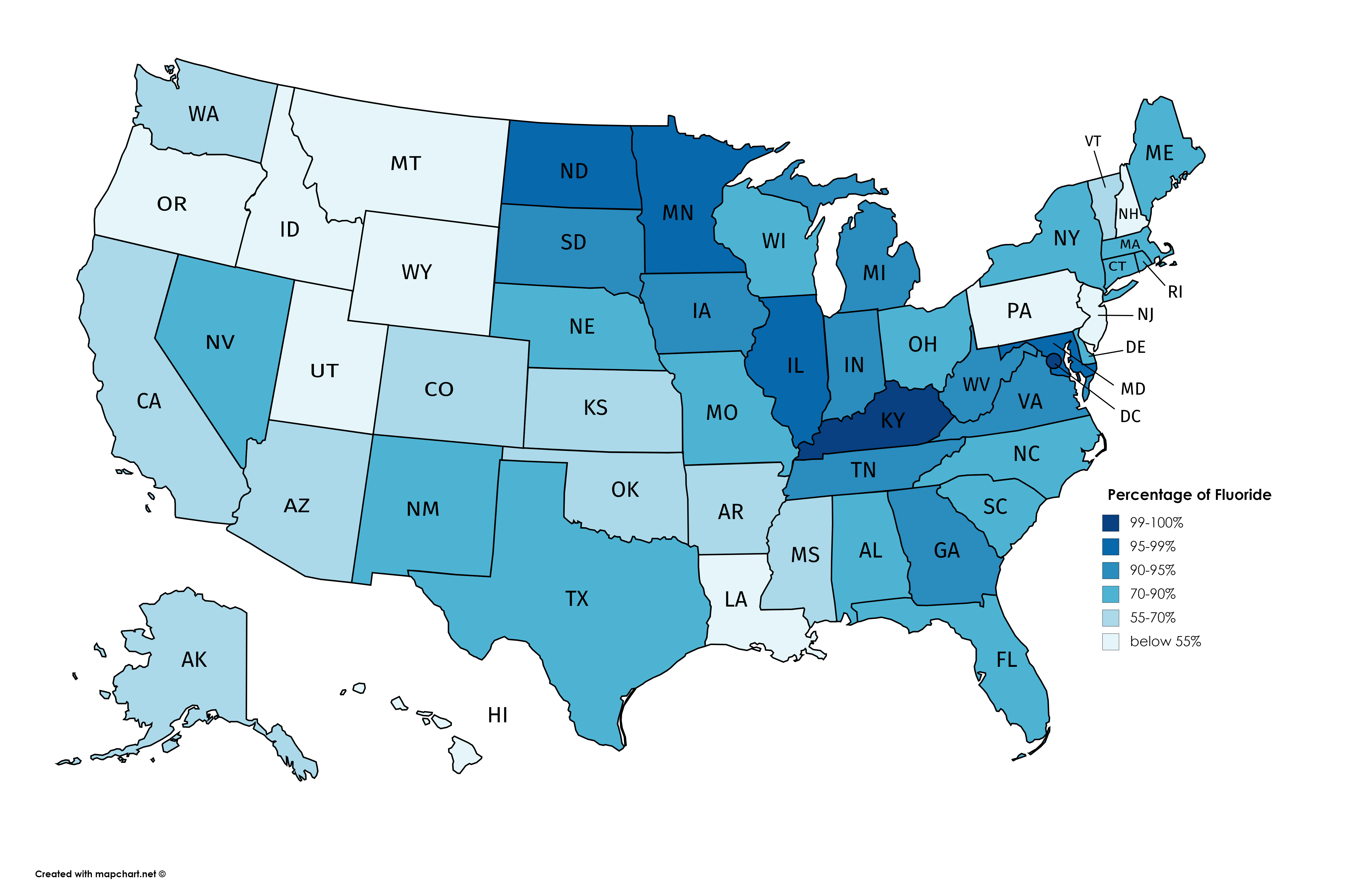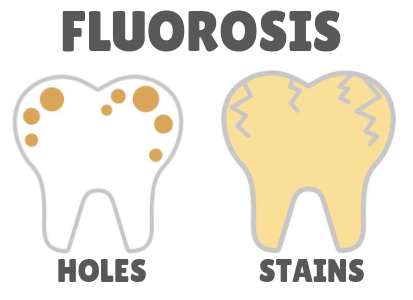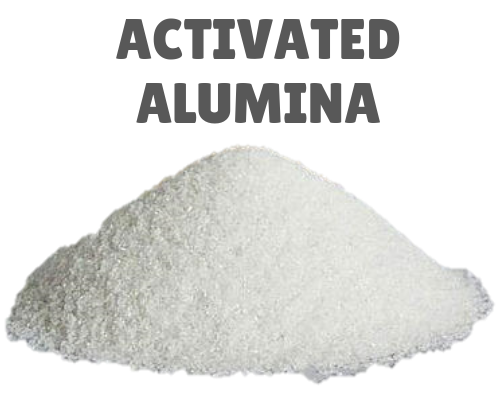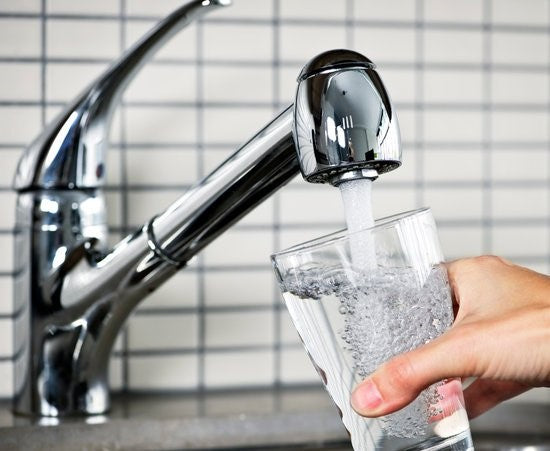It's in our toothpaste, at our dentist's office, and for most of us... in our tap water. Contrary to what we've been told, man-made fluoride is NOT good for us.
It’s most likely in your water
About 70 % of the U.S. has fluoride in their water. If you are on a municipal water supply chances are you have fluoride in your water. Some municipalities have opted out of fluoridation because of the outcry from locals who recognized the harmful effects of fluoride and fought to prevent unnecessary fluoridation in their cities. Some municipalities give you the option for adding it or opting out… If only most of America was lucky to have that option.
If you’re on well water chances are you won’t have fluoride in your water, although it does occur naturally, so it’s possible depending on your area and your local well. It’s always good to do a routine water test annually or bi-annually to make sure you know what’s in your well water.
The map below shows what percentage of each state has fluoride in it's municipal water. Only Washington DC has 100% fluoride levels, meaning every drop of DC tap water contains fluoride. Hawaii has the lowest percentage with only 10% of it's municipal water containing fluoride.

It’s a byproduct of the manufacturing process

Big Business lucked out by convincing local municipalities to buy their fluoride byproduct off them for cheap. Now they have an easy solution to offload their extra fluoride AND are getting paid for it. The sodium fluoride added by our municipalities has no nutritional value or health benefits and is an unnatural form of fluoride. It is a chemical by-product of aluminum, steel, cement, phosphate, and nuclear weapons manufacturing. Before the public was convinced that adding fluoride to their water was for their own good, the metal and chemical industries had the problem of disposing of their highly toxic fluoride waste. Now, thanks to corporate lobbyists and the big lie sold to the public about supposed health benefits, the fluoride waste is dumped into our municipal water supplies. Not only did this solve their toxic waste disposal problem but allowed them to sell it for a profit at a markup of 20,000 times.
It’s simply not good to ingest and a range of problems are associated with it.
 Consuming excess fluoride can lead to a whole host of problems. Contrary to what we have been told for many decades, man-made fluoride actually leads to fluoridosis. Fluoridosis, is a condition in which the teeth develop marks, stains, holes, and are weakened from consuming too much fluoride. It can also result in “hyperactivity and/or lethargy, arthritis, lowered thyroid function, lowered IQ, dementia, disrupted immune system, genetic damage, cell death, cancers, deactivated essential enzymes and lower life span.” It’s also worth noting that in Europe and US communities where there is no water fluoridation, cavities are less than in fluoridated US communities.
Consuming excess fluoride can lead to a whole host of problems. Contrary to what we have been told for many decades, man-made fluoride actually leads to fluoridosis. Fluoridosis, is a condition in which the teeth develop marks, stains, holes, and are weakened from consuming too much fluoride. It can also result in “hyperactivity and/or lethargy, arthritis, lowered thyroid function, lowered IQ, dementia, disrupted immune system, genetic damage, cell death, cancers, deactivated essential enzymes and lower life span.” It’s also worth noting that in Europe and US communities where there is no water fluoridation, cavities are less than in fluoridated US communities.
It's avoidable
Thanks to mass fluoridation of our municipal water supplies and inclusion of man-made fluoride in toothpastes and other dental and consumer products, most of us regularly consume excess amounts of it. Despite claims of dental health improvement, and regardless of it’s efficacy of preventing cavities or tooth decay, consuming it is simply unnecessary and dangerous. Think about it, you wouldn’t swallow your toothpaste, so why would you swallow water with the same active ingredient? Consuming such fluoride actually leads to worse dental health as well as a host of other very serious health issues. Though it may be nearly impossible to avoid fluoride entirely, there are ways to avoid it in your drinking water. Reverse Osmosis, Distillation, and Filtration are all viable options for removing fluoride. However only one of those technologies is ideal for residential use, as will be discussed in the next section.
Some technology is better than others at removing Fluoride
Fluoride is tricky to remove. It’s the only contaminant on the EPA’s Maximum Contamination Limit list that has a range instead of exact number. The enforceable MCL for fluoride is 4.0 mg/L (milligrams per liter) however the unenforceable limit (the highest they recommend) is 2.0 mg/L. The reason it's so tricky is that the variables for removal are much greater than most other contaminants. Currently the best method for fluoride reduction (when considering capacity, cost, and convenience) available in the industry is filtration using activated alumina.

Research studies have shown that activated alumina has a high potential for fluoride uptake and requires minimum contact time for maximum defluoridation. The ability of activated alumina to remove fluoride however depends on the chemistry of water. For example, hardness, silica, and boron, if present in the water will interfere with fluoride removal and reduce the efficiency of the system. The pH level of the water also factors into its efficiency, with high pH levels of 11.0 showing little removal while low pH levels of 5.0 being the optimal removal level. However, research shows that fluoride removal at neutral pH levels (levels most commonly found in municipal water) is substantial, and concluded that activated alumina in a continuous flow fluidized system is the most economical and efficient method for defluoridating water supplies.
Bonus: Methods that don’t work to remove fluoride






Leave a comment